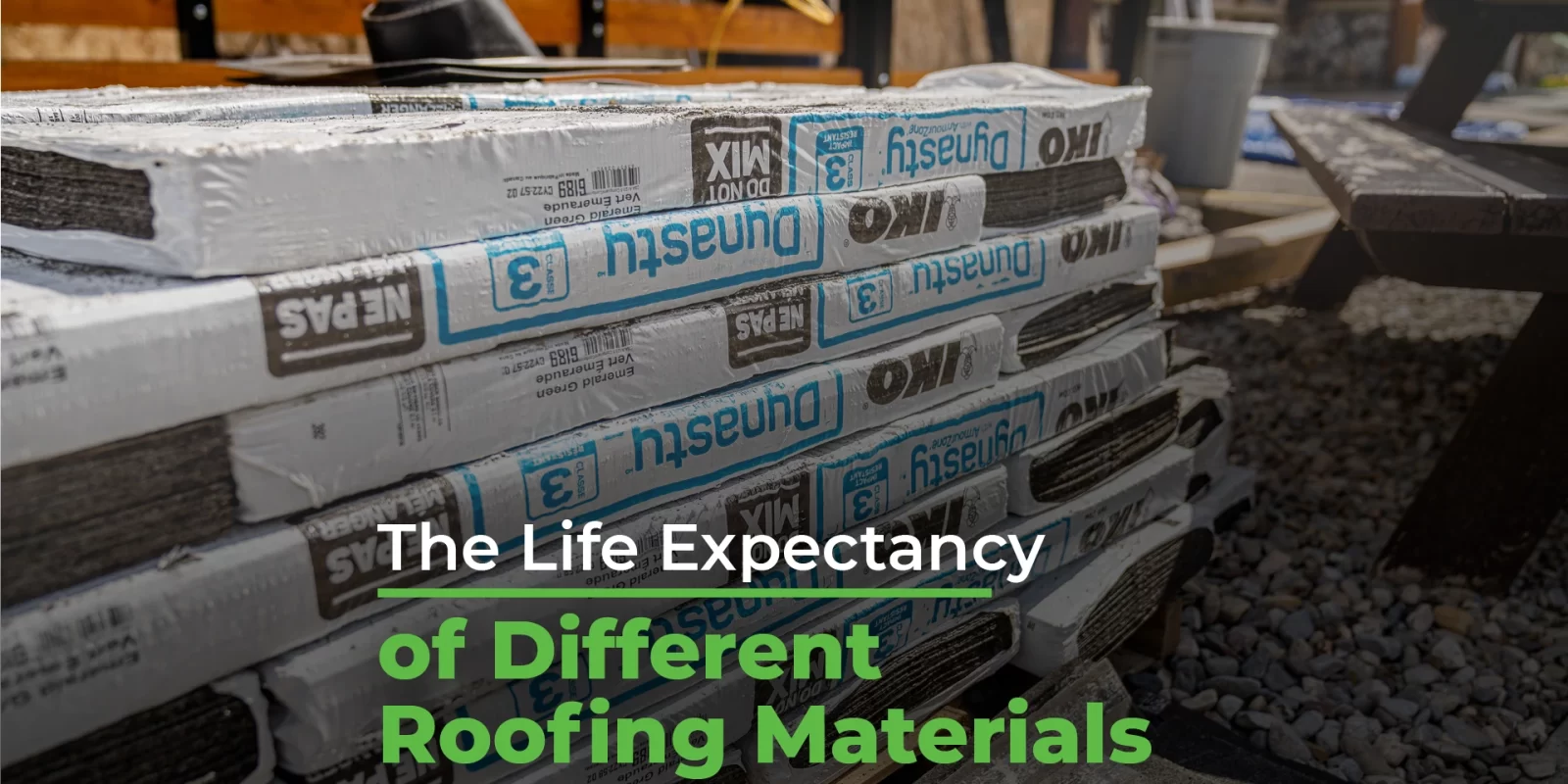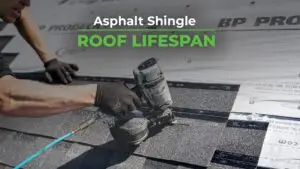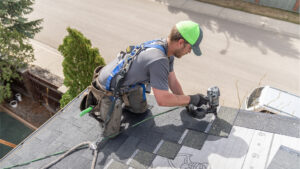The longevity of different roofing materials is impacted by several factors, which are important to consider when selecting the right option for your home or business.
Factors That Affect Roof Lifespans
Before we get into the specifics of how long different roof materials typically last, it’s important to understand the factors that affect their lifespans.
Climate
The climate in your area plays a significant role in determining how long your roofing material will last. Extreme weather conditions such as heavy rain, snow, hail, high winds, and prolonged exposure to UV rays can accelerate the wear and tear on your roof.
In southern Alberta, harsh winters, high winds, chinooks, and sun exposure play a big role in roof health. In southeastern BC, homes may face similar conditions with the added concern of ice damming.
Quality of Materials
The quality of the roofing materials you choose is crucial for determining their longevity. Opting for high-quality materials, even if they may be more expensive upfront, can provide better durability and resistance to damage. It’s important to select reputable brands and work with trusted suppliers or contractors who can guide you toward materials known for their longevity.
Proper Installation
The installation process significantly impacts the lifespan of your roof. Improper installation can lead to premature damage or even failure of the roofing system, requiring unexpected roof repairs or replacements. It’s essential to work with experienced and skilled roofing professionals who follow industry best practices and manufacturer guidelines for installation.
Roof Ventilation
Adequate roof ventilation helps maintain a consistent temperature and moisture balance in your attic, preventing heat buildup and condensation. Over time, ventilation issues can contribute to the deterioration of roofing materials.
Maintenance and Care
Regular maintenance and care are crucial for preserving the longevity of your roof. Routine inspections can help identify and address any issues early on, preventing them from escalating into more significant problems. Cleaning debris, removing moss or algae growth, and promptly repairing damaged areas can all contribute to the longevity of your roofing materials.
Environmental Factors
Other environmental factors, such as nearby trees or the presence of industrial pollutants, can affect the lifespan of your roof. Falling branches, leaves, or chemicals can cause physical damage or accelerate deterioration. Understanding the specific environmental challenges in your area can help you choose materials that are better suited to withstand them.
Typical Lifespans of Different Roofing Materials
With the above considerations in mind, we can dive into the standard lifespans of popular roofing materials and discuss how their longevity is impacted by these factors.
Shingles are one of the most popular roofing materials due to their affordability and wide range of styles. They are typically made from asphalt, fiberglass, or organic materials, and can provide excellent protection against various weather conditions.
The life expectancy of shingles can vary depending on the quality of the materials and the specific environmental factors they are exposed to. On average, asphalt shingles can last between 15 to 30 years. Fiberglass shingles tend to have a longer lifespan, ranging from 25 to 40 years. Organic shingles have a shorter life expectancy, typically lasting around 20 years.
To extend the life of shingles, consider the following tips:
- Regular inspections: Inspect your roof for any signs of damage, such as missing or cracked shingles, and promptly address them.
- Gutter maintenance: Keep gutters clean and free of debris to prevent water from backing up and damaging the shingles.
- Proper attic insulation: Adequate insulation helps maintain consistent temperatures and prevents ice dams from forming.
- Regular cleaning: Remove any debris, moss, or algae that accumulate on the roof to prevent damage and ensure proper drainage.
Metal roofing has gained popularity in recent years due to its durability, longevity, and aesthetic appeal. It is available in various materials, including steel, aluminum, copper, and zinc. Metal roofs are known for their exceptional resistance to extreme weather conditions, making them a reliable choice for many homeowners.
On average, metal roofs can last anywhere between 40 to 70 years or more, depending on the material and proper maintenance. Steel roofs typically last around 40 to 60 years, while aluminum roofs can endure for 50 to 70 years. Copper and zinc roofs have an even longer life expectancy, often exceeding 100 years.
Metal roofing offers numerous benefits, including:
- Durability: Metal roofs are highly resistant to impact, fire, and extreme weather conditions such as hail, wind, and snow.
- Longevity: Metal roofs have an exceptionally long lifespan compared to many other roofing materials.
- Energy efficiency: Metal roofs can reflect heat, reducing the cooling load and potentially lowering energy bills.
- Low maintenance: Metal roofs require minimal maintenance and are relatively easy to clean.
Lifetime roofing materials are known for their exceptional durability and extended lifespan. These materials are designed to withstand the test of time while providing superior protection for your home. Some popular options for lifetime roofing materials include rubber, tile, composite, and shakes.
On average, rubber roofing can last up to 50 years, tile roofing can endure for 50 years or more, composite roofing can last for 30 to 50 years, and shakes can provide a lifespan of 30 to 50 years.
- Rubber Roofing: Rubber roofs are known for their excellent weather resistance and energy efficiency. They are relatively low maintenance and can be an eco-friendly option. However, they may require professional installation and periodic inspections to ensure proper performance.
- Tile Roofing: Tile roofs offer outstanding durability, fire resistance, and a classic appearance. They are available in various styles and colors, allowing for customization. However, they are heavier than other roofing materials, requiring proper structural support during installation.
- Composite Roofing: Composite roofs combine the benefits of durability and aesthetic appeal. However, the quality of the materials can vary, so it’s essential to choose a reputable brand for long-lasting results.
- Shakes: Shakes provide a unique and natural look to a home’s exterior. They offer good insulation properties and can withstand wind and impact. However, shakes require regular maintenance, including periodic cleaning and treatment, to prevent issues like moss or rot.
How Do You Know What to Choose?
When considering the life expectancy of different roofing materials in southern Alberta and southeastern British Columbia, several factors come into play. The climate, quality of materials, proper installation, roof ventilation, maintenance and care, and environmental factors all influence the lifespan of a roof.
Roofs that are designed to last longer come at a higher cost up front, but can save you a good amount of money in the long run. It’s important to weigh the costs of paying for a more durable roof up front against the costs of replacing your roof sooner or navigating more frequent repairs. There’s no one-size-fits-all answer, and your decision will depend on your budget, your aesthetic preferences, the climate of your region, and other contextual factors.
Each material has its own set of advantages and considerations, such as durability, energy efficiency, and maintenance requirements. By carefully considering these factors, homeowners and businesses can make informed choices that ensure their roofs provide long-lasting protection for years to come.




